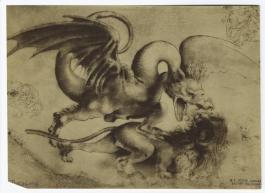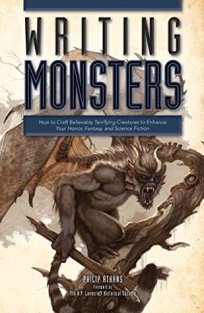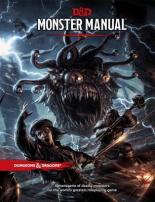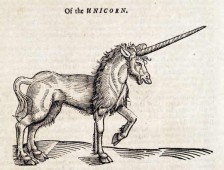
[Editor’s Note]
The QE household has prepared itself for the onslaught of sugar-craving children. I figured today (Halloween) would be a great day to repost an older blog about monsters to free me up for pumpkin carving and other fun things. Since writing this post, I purchased Cryptozoology A to Z, by Loren Coleman and Jerome Clark (thanks to a suggestion offered by Dillon, over at From Rad to Dad). It’s a very organized glimpse into the monsters of all shapes and sizes.
While I love reading most genres, few things give me more pleasure than reading about monsters chowing down on unfortunate locals. It can be zombies, aliens, rodents of unusual size, or anything else you can think of. I enjoy it even more when the writer creates a new beast for me to add to my bestiary archives.
I‘m currently working with a couple writers who both have monsters in their books. The human chomping freaks are terrifying and enjoyable to learn about. One issue we have been sorting out together is how they can describe the monsters clearly.
This lack of description becomes a larger issue when you have spawned a new breed of monster. When you say dragon, I know what you are talking about. At the very least, I have an idea of what you are talking about. But if you go springing an ancient force hell bent on sucking out my eyes and using my spine as a fiddle bow, then I need to some details.
 I recently snagged Philip Athans’ book, Writing Monsters, to help me find some creative solutions to provide. By recently, I mean it came in the mail yesterday. I sat down to read with a highlighter in hand and a notepad ready to jot down ideas. My plan was to pull all the pertinent information from the book and compile a list the writers could use to beef up their monster description. I hit page eight, and bang, there was a goldmine.
I recently snagged Philip Athans’ book, Writing Monsters, to help me find some creative solutions to provide. By recently, I mean it came in the mail yesterday. I sat down to read with a highlighter in hand and a notepad ready to jot down ideas. My plan was to pull all the pertinent information from the book and compile a list the writers could use to beef up their monster description. I hit page eight, and bang, there was a goldmine.
Athan had created a template called, “The Monster Creation Form.” I’m not going to reproduce that simple, but genius, form here. I think that level of borrowing would border on copyright infringement. It did get me thinking about a similar form I used to play with a lot – a Dungeons and Dragons (D&D) character sheet. I’ve done a blog post on character sheets before, which has examples. You can check that out here. If your monster is quasi-human, you might be able to use one of the templates I provided there.
 I also ordered the D&D Monster Manual (the version I linked). I could remember a younger version of me flipping through one of these and marveling at both the written descriptions, variety, and artwork. I figured the older version of me could use another point of reference.
I also ordered the D&D Monster Manual (the version I linked). I could remember a younger version of me flipping through one of these and marveling at both the written descriptions, variety, and artwork. I figured the older version of me could use another point of reference.
After the euphoria of my Amazon impulse buy wore off, I began searching for D&D type templates to build monsters. After some internet scouring I ended up right back here on WordPress. I found a blogger, OldDungeonMaster, who has a literary ton of great D&D related materials. One such item was a monster sheet for a Cranium Rat. You can look at the image below. I also linked this image to his/her page so you check out the rest their content (for you aspiring D&D players and Dungeon Masters).
 I combined some elements from the monster sheet above, and some elements from Writing Monsters, and created my own Bestiary of Destiny. You can use this template to sketch out your monster and assign elements. While I’m no artist, I sometimes find even a crude drawing helps me better understand how something looks. It helps pull the description out of the creative whirlpool in my head and give it shape.
I combined some elements from the monster sheet above, and some elements from Writing Monsters, and created my own Bestiary of Destiny. You can use this template to sketch out your monster and assign elements. While I’m no artist, I sometimes find even a crude drawing helps me better understand how something looks. It helps pull the description out of the creative whirlpool in my head and give it shape.

If you click the image it will send you to my Flickr page where I uploaded this image in higher resolution. Print it in landscape and have some fun. As with anything I create for the blog, it’s free to share and use for whatever nefarious purpose you have in mind.
Many times when I talk to writers about description, they know all the answers. I’ll say something like, “It was great when Zolgorg the Mighty ate that guy. What does Zolgorg look like when he eats someone? Does he tear them in two and go into a blood frenzy, or does he carefully quarter them?” Usually the writer will launch into a five minute description-fest explaining the ordeal in fine detail.
 When they wrote the scene, the information was clear in their head, it just didn’t make it onto the page. In my own writing, having visual references (like character sheets and templates) reminds me to include those descriptions. I make sure to stick the papers up on the wall in front of me, or somewhere I can see them. This way when the time comes for juicy description, a glance at those papers zeroes me in on important descriptive elements.
When they wrote the scene, the information was clear in their head, it just didn’t make it onto the page. In my own writing, having visual references (like character sheets and templates) reminds me to include those descriptions. I make sure to stick the papers up on the wall in front of me, or somewhere I can see them. This way when the time comes for juicy description, a glance at those papers zeroes me in on important descriptive elements.
If you are having issues being consistent with description, or generating a clear picture of what your monster should look like, I encourage you to try this tool. Worst case scenario is you have a crudely drawn picture, but a clearer mental one.
 That’s it for today. I hope you found some useful tools to create your own monsters here. I’m sure as I continue reading through Writing Monsters some more nuggets of information will accumulate. You can look forward to some posts about flesh chewing chinchillas and what not.
That’s it for today. I hope you found some useful tools to create your own monsters here. I’m sure as I continue reading through Writing Monsters some more nuggets of information will accumulate. You can look forward to some posts about flesh chewing chinchillas and what not.
Do any of you have effective ways to create new and terrifying monsters? Or know of good books on crafting monsters? If you are willing to share I would love to hear about it. Until tomorrow, keep reading, keep writing, and as always – stay sharp!

I have a few cryptologist books I refer back to as well as a guide to Greek mythological monsters. I pour over them from time to time picking what I like about the way they look or a special characteristic they have. I have always kind of mocked up different “character sheets” for my monsters or characters but I haven’t had a actual sheet, I will be stealing these, thank you!
LikeLiked by 3 people
*smacks forehead*
Mythology and Cryptozoology books – why didn’t I think of this? Yet another reason why I love blogging. Thanks for giving me a couple more directions to run of into and gather information, you rock.
Think I will see some zombie velociraptors in there? If not, you should probably make that happen.
Thanks for reading today and offering me some solid input.
LikeLiked by 2 people
Haha, I toyed with the idea of writing a short story around them…maybe I will! Thanks for the motivation!
LikeLiked by 2 people
You can count me in as a reader!
LikeLiked by 2 people
Crafting of creatures is one of the most essential parts of worldbuilding. It’s a challenge, but can be great fun. Thanks for this fun article.
LikeLiked by 1 person
Glad you enjoyed reading it! I just took a glance at your blog and absolutely love the illustrations you have there. I will spend some more time creeping around on your page tonight when I get some free time.
Thanks again for reading and leaving some thoughts. Happy to connect!
LikeLiked by 1 person
Oh. Thank you. 🙂 Watch out for ROUSs.
LikeLiked by 1 person
Very nice, I will definitely use that sheet! I need to write something which is not _exactly_ a monster in the classic sense, but certainly fits extended definitions, and it hadn’t occurred to me before that it probably needs some sort of variation on a character sheet. It hasn’t made any kind of appearance yet – ominous noises at the most – so I won’t have to do any kind of rewriting if I discover new and interesting things about it in the process.
LikeLiked by 2 people
I like that you are doing the slow reveal with your monstrous creation. Nothing like a little tension and buildup to get people invested and flipping those pages.
You mentioned your monster is a quasi-monster (or variation of some kind). One thing I’m really enjoying about the book, Writing Monsters, is how dynamic the concept of monsters really is. The whole first section of the book examines different literary definitions of the word and concept. My takeaway so far is not to stress about defining a creation, just write whatever you want and let the critics and reviewers try to sort out the definitions. If anything, it generates debate about the book, and that’s a good thing (people talking and all of that).
Best of luck to you as your breathe life into your creations. Thanks again for reading.
LikeLiked by 2 people
I saw that first comment. Cryptozoology is crucial. Perception of War has a ton of alien races. You’re reading about Akal in 1,200, who is tough to write because of his natural state vs his tendency to shift forms. I chose to make up for that by making his motivation and though process clear.
LikeLiked by 2 people
Akal is a brilliant monster made more terrifying/enjoyable by his motivations and thought processes. Plus some other tasty features, but that’s enough teasers! I can’t wait to get into Perception of War, but first, I think you have a short story to write using one of those characters…
I have no idea why I didn’t think of cryptozoology in the first place…my brain is a dog chasing it’s tail sometimes. You know this.
Thanks for swinging in today!
LikeLiked by 2 people
This is a perfect illustration of the joy of being who we are and how we think and why it might matter a thousand years from now. Even if no one were left on this planet, your post will be traveling through space and time, seeking that which may (or may not) return before you can turn out the light this very evening, as you are brushing our teeth, and wondering … “what was that sound?” #30
LikeLiked by 2 people
Thanks for this interesting comment! I always enjoy a fresh perspective. To avoid those bumps in the night while brushing my teeth, I shall no longer brush them! One problem solved…now about my fear of dentists.
LikeLiked by 2 people
Creating monsters is all kinds of fun! I’m a huge fan of monster movies however, I prefer it if the monster is in shadows most of the story. That isn’t to say I don’t love to know what the beastly creation of an author or director looks like, just it is that much more terrifying with the right balance of description (without giving too much away).
If in film, it is so awesome if they keep the monster a secret looks wise at the very least until the end. Though, if it is going to look like some hokey cheese fest in a non SyFy original movie, then I’d prefer they don’t show it at all.
In books though I don’t mind as much unless it’s horror. If it’s fantasy it is a tad different. I don’t know if I’m making a ton of sense, but in horror, half the terror in a monster is from the mystery of what is stalking you and/or your town and killing people.
Then again there are exceptions where knowing everything is far more terrifying depending on the Monster and the writers description. I LOVED reading D&D guides and books just for the art and monsters.
I still do enjoy it, though being out here, it has been hard to find anyone who will play properly and I haven’t had the time to really teach my wife…yet. 😉
Great article, and very useful.
Cheers! ^_^
LikeLiked by 3 people
“…half the terror in a monster is from the mystery of what is stalking you and/or your town and killing people.”
I absolutely agree with this. I think of Jaws. I know it’s an overused example, but it’s such a solid one. It takes 90 minutes before the shark pops out of the water in full glory. They take their time giving you hints and showing bits and bobs, but no real full shark until the 90 minutes mark. I’ve heard it wasn’t intended to be this way initially, (mechanical issues with the prop shark during shooting) but regardless, it proved what you can do with a little tension and suspense.
Good luck getting the wife on-board with D&D! One of these days when the schedule is easier, I will likely try to do the same thing.
LikeLiked by 2 people
Jaws is a perfect example. Yes, the wife would love to learn and get into it, just time management and life. Xp Fingers crossed, we can get into the apartments we are looking into, and get out of this hell on earth, and I’ll have all the time to teach her.
Good luck with getting your wife on board as well. ^_^
LikeLiked by 1 person
Thanks for this! Maybe I’ll get brave enough to create some monsters–for RPGs or novels.
LikeLiked by 2 people
The best thing about making you own monsters will be that the seasoned players at your table will be at a loss for what to do. As much as I loved playing with my friends, there were always a couple individuals who had every stat in every book memorized. So when the DM would say X monster appears, said person(s) would launch into an oral history about X monsters stat’s weaknesses and general information. I think every table has one or two of those people 😀
Thanks for stopping in and reading. I hope you are able to find some use for my basic template and other information.
LikeLiked by 2 people
Reblogged this on Still Another Writer's Blog.
LikeLike
Ah, monster creation. A key point to many books that I find many authors willing to forgo, which is all too easy given the plethora of already-created and readily-available monsters, such as the dragon you suggested. Yet, I think monster creation is vital. The description is even more important because it shows a level of world-building beyond the normal boundaries. It’s not just a country, a landscape, a people. It’s the nightmares. The predators. The things that stalk your characters in the night and that can be a plot element to utilize, but I personally believe it’s a world-building aspect through and through.
Yet, I would agree that many people do it incorrectly. I can’t count the number of paranormal or fantasy books that have creatures and I just sit there going: ‘what the heck is it?’ Having a cheat sheet for the creature will be great, but the real skill is learning how to implement said characteristics in a manner that doesn’t feel like info-purge. Listing off characteristics won’t make the reader feel something about the creature, but implementing them into the scene and having the characters interact with them will add a much more life-like effect to the creature.
LikeLiked by 2 people
Great comment! The books I enjoy reading usually reveal monster/creature description through action. The teeth are described when they chew, the claws when they rip, and so on. By pairing the description with action the author tackles two obstacles at once. Also because the description is given during tense moments the emotional impact is ingrained in my head. I don’t just think about when the beast ripped someone in two, I think about what those claws would feel like if I suffered that fate.
LikeLiked by 2 people
Exactly!
LikeLiked by 2 people
In the novella prequel to my first novel I have a “monster” that is chasing my troops through a dark and derelict space station…. but when the monster is revealed, it turns out that the monster is a human… The monster is us, which turns into a deep metaphor that came to light when I was done as I never intended it. Realistically, the monsters CAN be us; Jeffery Dahmer, Hannibal Lector, Jack the Ripper. etc..
–> Did I use the semicolon right? 😛
LikeLiked by 1 person
That’s a brilliant concept and one I really enjoy. I haven’t asked or looked, but are your books available through your blog page? If not, where can I snag them? I have a blog post somewhere where I link WordPress bloggers and their books when I buy them. (I think you needed a plain Jane colon there)
LikeLiked by 1 person
LOL, I thought so too but since you didn’t do a post recently about PLAIN COLONS,… only SEMI’s!!
My book is available in Beta at the moment. I will link to how you can read it, but it should be available for sale within the next few weeks. I’d love to have you as a beta reader! 😉
http://humanlegion.com/battlenet/
LikeLiked by 1 person
I really WISH I could beta read it but I’m already alpha reading two books and editing two others (and writing my own). But I will certainly buy it. Your genre is one I love reading.
It might be a while before I dive into more grammar/punctuation posts – that’s a subject I still have to break open the books to confirm information, so I don’t feel safe trying to teach others. Someday I’ll be a wizard at it though.
LikeLiked by 1 person
I’d say I would be too but I’m content trusting my editors!!! 🙂
LikeLike
Great post. While I don’t often write monsters, I have found in the past that the first thing I tend to do is to determine what the pertinent features of the monster are. Too much description on the page can bog the reader down and also eliminate any sense of mystery or fear the monster might have inspired in the reader. So if it’s grabbing someone from underground, does it have long fingers or short, curled claws? If it’s biting someone in half, are its teeth more like serrated knives or needles? If it’s peering out of the darkness, what color are its eyes? If you can convey all the aspects of the monster that are necessary to clearly describe what it’s doing and how it affects the characters/plot, the reader should be able to supply the rest, and hopefully whatever the reader comes up with will be the scariest thing they can think of.
LikeLike
Reading this post made me think of my childhood. My mother loves the show, V (for visitors) – the old one. http://www.imdb.com/title/tt0085106/ I have watched the show with her when I was a kid and it totally scared me. I was like aliens …. evil… scary… I’m not food!! lol
I’m not a fan of monsters too much, unless they are dragons and I don’t consider dragons to me monsters so I don’t have any site or book recommendations.
LikeLiked by 1 person
I haven’t seen this. I’ll give it a whirl when I get some time. No worries on book recommendations, I’m just happy you stopped in to read.
LikeLiked by 1 person
^_^ Me too. Caught up on most things I’ve missed on here. Also, I did post the blog post about a tree and about flowers today
LikeLiked by 1 person
Call me weird but I really enjoy creating monsters, this is so fun!! I do it in my head though, that’s where most of my writing takes place, I just have to sit still, close my eyes and imagine..
Meno
LikeLiked by 1 person
I’m proud of the fact that I can still remember all of the stats terminology on the rat’s sheet. Sigh…nostalgia…
I’m definitely looking into that book.
LikeLiked by 1 person
Awesome tool! 🙂
LikeLiked by 1 person
Glad you thought it was useful. The book is loaded with templates for different creatures. If you’re into the monster scene I also recently snagged Cryptozoology A to Z, by Loren Coleman and Jerome Clark. It’s basically an encyclopedia of monstrous creations.
Thanks for taking the time to read and good luck with your writing.
LikeLike
Oh no, more books for me to buy. I came home today to find my copy of Writing Tools and now you give me three!
On the plus side, monsters. Who doesn’t love writing monsters? One of my earliest memories is creating monsters for a school project, either to do with horror or Greek mythology… Probably mythology. But it’s still something I’ll do for fun from time to time.
In fact… I may have to look at monster creation for my next short…
LikeLiked by 1 person
I’m trying to think, but have you used any monsters in your shorts? Certainly the “man is the real monster” is used—but I’m can’t think of a true-to-life monster.
LikeLiked by 1 person
I don’t think I have yet. Time to get creating!
LikeLiked by 1 person
I think the closest thing I’ve got, now that I’ve thought about it, is the Seraph in the Describe Heaven short. Though it;s more of a construct… Does that count?
LikeLiked by 1 person
Anything and everything can be a monster from a certain point of view…so sure! I’ll do a search on your page when I get some time and check it out 🙂
LikeLiked by 1 person